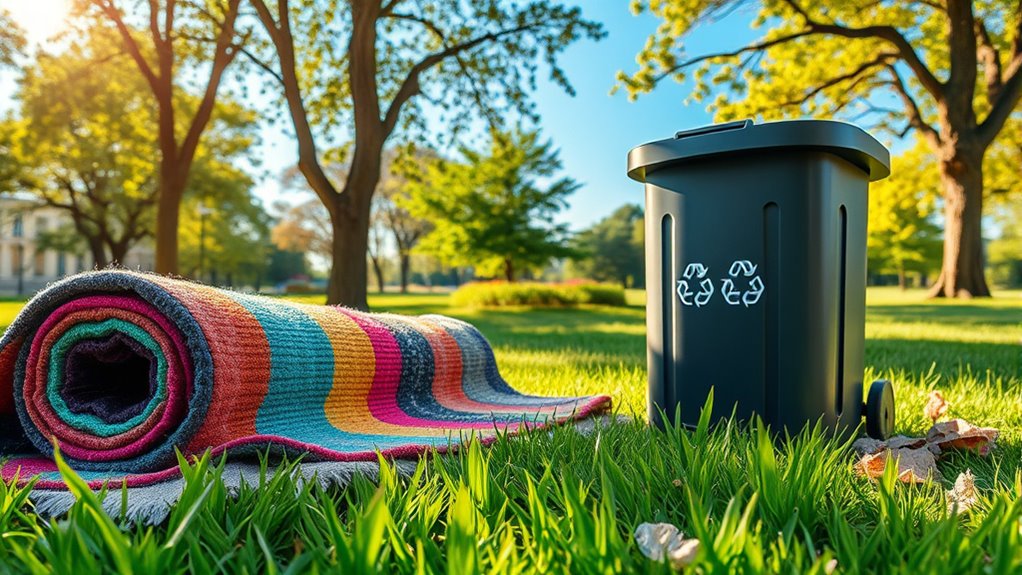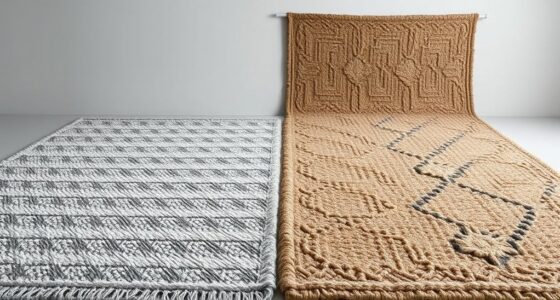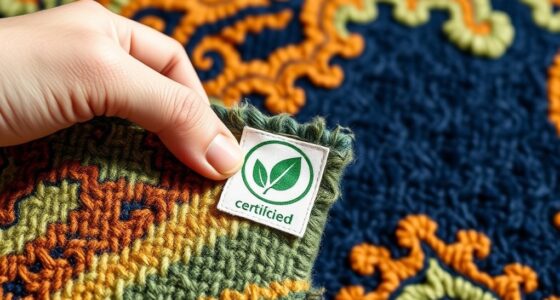To dispose of or recycle your rugs eco-friendly, consider donating them to charities, upcycling into new home items, or exploring local recycling programs for synthetic or blended materials. You can also partner with eco-conscious recycling centers that safely break down fibers and dyes. Proper waste management includes following local regulations and avoiding landfill disposal. To extend your rug’s life and reduce waste, try maintenance tips or community sharing options. Learn more about eco-friendly rug disposal as you explore these sustainable options.
Key Takeaways
- Donate rugs to charities or shelters after cleaning to promote reuse and reduce waste.
- Upcycle old rugs into home decor, insulation, or utility items to extend their lifespan sustainably.
- Use local recycling programs or specialized facilities that handle synthetic and blended rug materials responsibly.
- Follow local disposal regulations, separating recyclable fibers and avoiding landfill dumping of hazardous chemicals.
- Support community initiatives and environmentally friendly practices to minimize textile waste and promote eco-conscious disposal.
Donating Your Old Rugs to Charitable Organizations

Donating your old rugs to charitable organizations is an eco-friendly way to give them a second life. Before handing over your rug, make sure it’s clean and free of stains. Rug cleaning and stain removal are essential steps to make your donation more appealing and hygienic. Use gentle cleaning methods to remove dirt, dust, and spots, which not only prolongs the rug’s lifespan but also shows respect for the organization receiving it. If stains are stubborn, consider professional stain removal techniques or deep cleaning. A well-maintained rug will be more likely to find a new home and be appreciated by someone in need. Additionally, understanding the importance of sustainable practices can motivate you to continue making environmentally conscious choices. Recognizing the cycle of waste associated with discarded textiles can inspire more responsible disposal methods. Incorporating recycling options into your routine ensures that your old rug is repurposed rather than simply discarded. Exploring upcycling ideas can help transform your rug into something new and functional, reducing waste even further. By taking these simple steps, you help reduce waste and support sustainability efforts while giving your old rug a meaningful second chance.
Recycling Programs for Synthetic and Blended Rugs
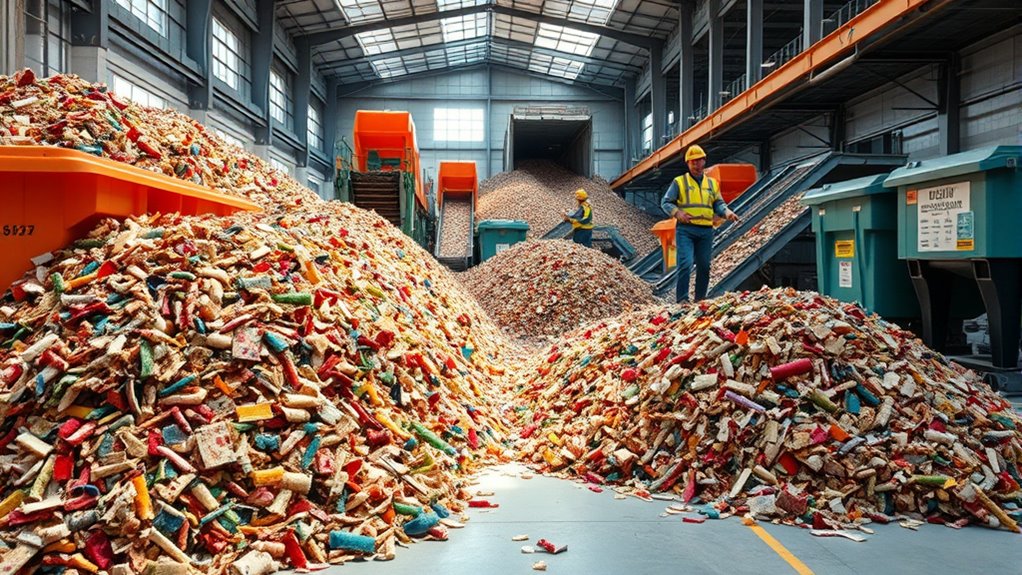
When traditional donation options aren’t suitable, recycling programs provide a practical way to handle synthetic and blended rugs. These programs accept rugs made from synthetic fiber or blended material, ensuring they don’t end up in landfills. To maximize recycling efforts, consider these options:
Recycling programs effectively handle synthetic and blended rugs, preventing landfill waste through specialized processing options.
- Check with local recycling centers that process synthetic fibers and blended materials, as they often have specialized equipment. Proper recycling techniques help reduce environmental impact and ensure materials are reused effectively.
- Use manufacturer or retailer take-back programs, which often refurbish or repurpose rugs made from synthetic or blended fibers.
- Explore dedicated carpet recycling facilities that break down rugs into raw materials, such as plastics and fibers, for reuse in new products.
- Be aware that cookie consent practices may influence the availability of online resources and recycling program information.
- Educate yourself about recycling regulations to ensure compliance and enhance the efficiency of your disposal efforts.
Upcycling and Creative Reuse Ideas for Old Carpets

Old carpets can become beautiful art pieces or unique home decor when you get creative. You can also transform them into useful items like doormats, storage bins, or pet beds. These upcycling ideas help you give your carpets a new purpose while reducing waste. Additionally, consider repurposing old carpets as insulation material to improve energy efficiency in your home. When planning these projects, understanding environmental impact can help you choose the most sustainable options.
Turning Rugs Into Art
Ever thought about transforming worn-out rugs into stunning pieces of art? Upcycling old carpets allows you to showcase craftsmanship and creativity. Start by carefully cleaning the rug, ensuring it’s free of dirt and debris through proper rug cleaning techniques. Then, consider traditional weaving methods to incorporate new textures or patterns, giving the piece a fresh look. Here are some ideas to elevate your project:
- Create wall hangings – Frame sections of the rug for a unique, textured art piece.
- Design patchwork art – Cut and sew different rug sections into colorful, abstract mosaics.
- Make decorative pillows – Repurpose smaller areas into vibrant, textured cushions. Additionally, exploring sustainable practices in upcycling can inspire eco-friendly approaches to repurposing your old rugs. Incorporating natural materials such as jute or hemp into your projects can further enhance the eco-friendliness of your upcycled art.
Using personal development techniques like goal setting and mindfulness can help you approach your creative projects with more focus and enthusiasm.
Crafting Utility Items
Transforming worn-out rugs into functional items extends their life and reduces waste while adding a personal touch to your home. You can repurpose old carpets into useful items like door mats, cushion covers, or even wall art. This process involves cleaning and cutting the rug to desired sizes, then sewing or attaching additional materials for durability. Upcycling also supports eco-friendly practices by preventing carpets from ending up in landfills. If you’re involved in rug manufacturing or carpet installation, you know how quickly old rugs accumulate. Instead of discarding them, consider creative reuse options. For example, cut sections of your carpet for pet beds or use scraps as protective floor padding. These ideas not only save money but also make your space more customized and sustainable. Incorporating upcycling techniques for carpet reuse further enhances environmental benefits and promotes sustainable living. Additionally, exploring Halloween traditions around the world can inspire themed decor projects for your home, blending cultural elements with eco-friendly craft ideas.
Local Disposal Regulations and Eco-Friendly Waste Management
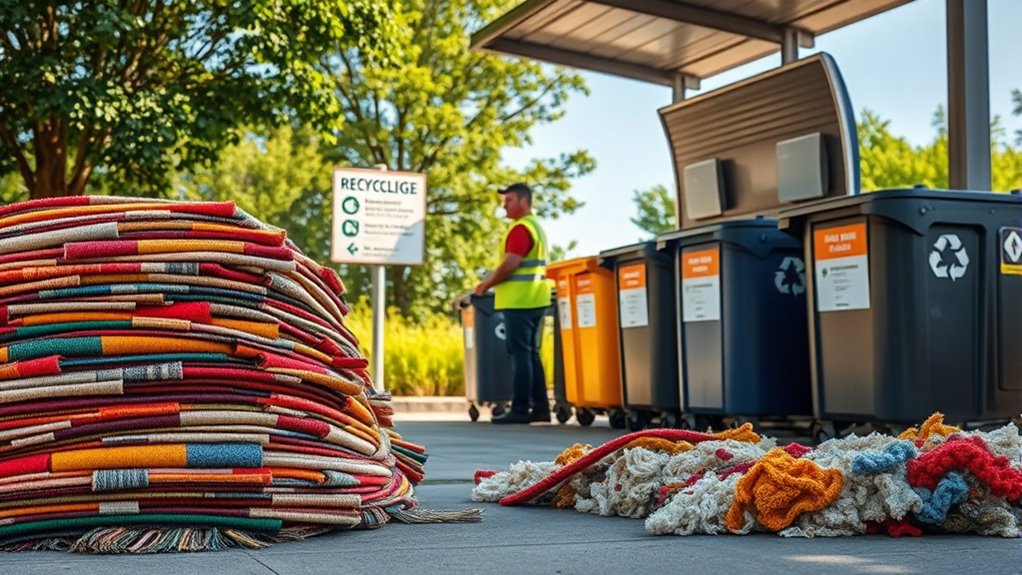
You need to understand your local disposal regulations before getting rid of your rug to avoid fines or environmental harm. Check your community’s recycling guidelines to see if your area accepts carpets or if special arrangements are required. Following these rules helps guarantee your waste management is both legal and eco-friendly. Additionally, consider exploring recycling options for large items that may include specialized collection or drop-off centers for carpets and rugs. Be aware that some regions may require bona fide recycling facilities that are equipped to handle bulky waste like carpets and rugs properly. Incorporating attention to creative practice can also help identify innovative ways to repurpose or reuse old rugs creatively instead of disposal. Being aware of local disposal regulations ensures your rug disposal aligns with environmental standards and community policies.
Legal Disposal Requirements
Understanding local disposal regulations is essential for environmentally responsible rug disposal. You must guarantee legal compliance by following specific disposal regulations set by your municipality. Failing to adhere can lead to fines or environmental harm. To navigate this, consider these key points:
- Check if your local authorities specify approved disposal methods for large textiles.
- Determine whether hazardous materials, like dyes or chemicals, require special handling.
- Verify if there are restrictions on landfill disposal and preferred recycling or donation options.
- Utilizing environmentally friendly disposal options, such as self-watering plant pots, can promote sustainable waste management practices.
- Being aware of recycling regulations helps ensure your disposal methods align with eco-friendly standards.
- Incorporating sustainable practices can also contribute to reducing carbon footprint and supporting overall environmental health.
Community Recycling Guidelines
Community recycling guidelines play an essential role in ensuring your rug disposal aligns with local waste management efforts. To follow eco-friendly practices, you need to consider local regulations about handling various carpet fiber types, such as wool, nylon, or polypropylene. These guidelines often specify how to separate recyclable materials and what items must be disposed of differently. Staying updated on rug color trends can help you identify which rugs are more environmentally friendly, like natural fibers, and therefore more suitable for recycling. By adhering to community recycling rules, you help prevent unnecessary landfill waste and promote sustainable waste management. Always check your local waste authority’s website or contact them directly to understand specific disposal requirements for your rug, ensuring you’re contributing to a greener community.
Partnering With Eco-Conscious Rug Recycling Facilities
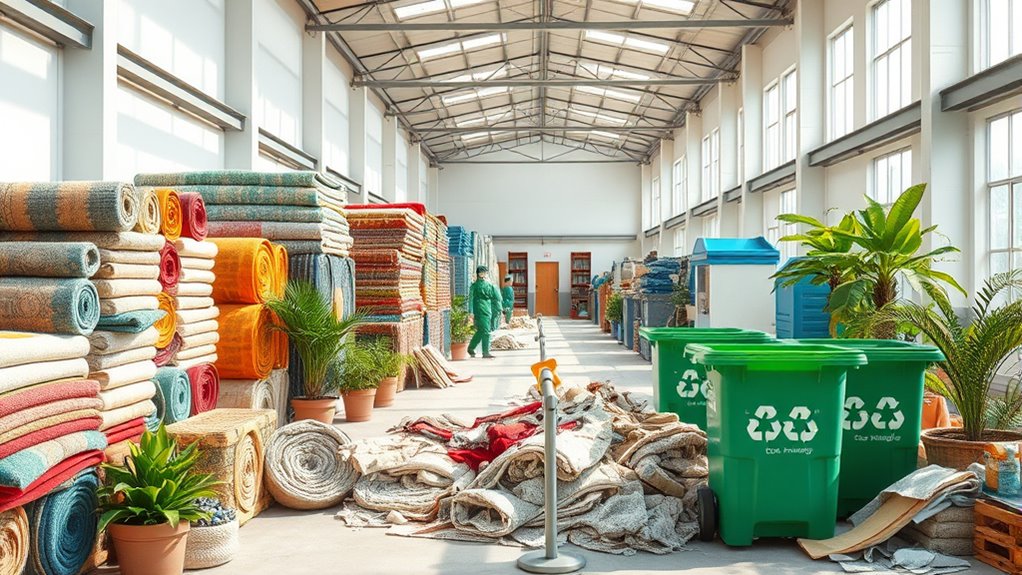
Partnering with eco-conscious rug recycling facilities is a crucial step toward sustainable disposal. These facilities specialize in handling rugs with fiber contaminants and guarantee dye stability, preventing environmental harm. When choosing a partner, consider these factors:
- They perform thorough fiber contaminant removal, reducing harmful waste.
- They maintain dye stability during recycling, preserving color integrity and minimizing chemical use.
- They follow strict environmental regulations, ensuring eco-friendly processing methods.
Repurposing Rug Materials for DIY Projects
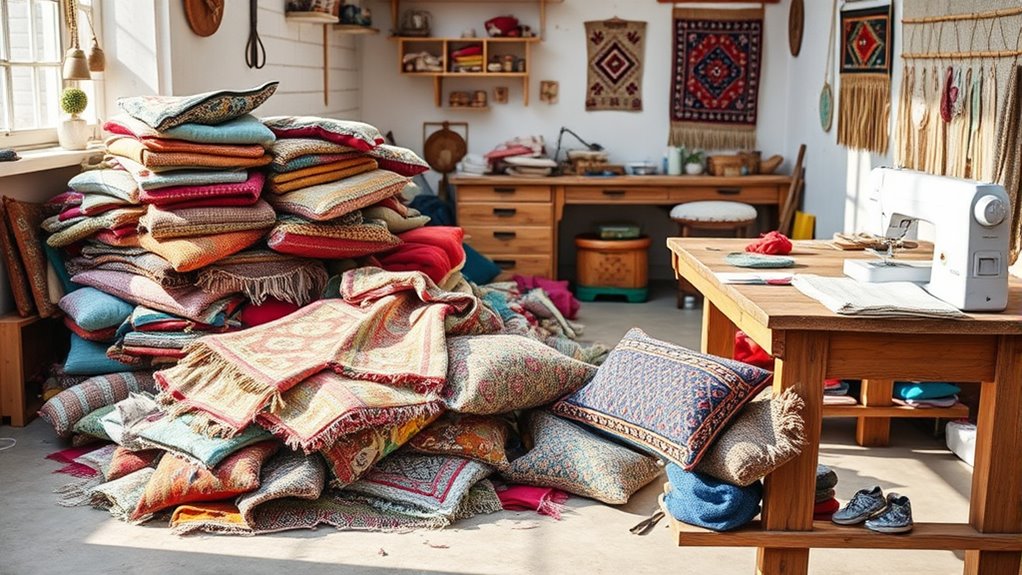
Repurposing rug materials for DIY projects is a practical way to extend their usefulness and reduce waste. You can transform old rugs into decorative rug accents, such as wall hangings, cushion covers, or placemats. Before repurposing, use proper rug cleaning techniques to ensure they’re fresh and safe. This step is vital for maintaining durability and appearance. Consider the rug’s material and thickness when choosing a project. Here’s a quick guide:
| Project Type | Suitable Rug Material | Tips |
|---|---|---|
| Wall Hangings | Woven or flat rugs | Use sturdy backing for support |
| Cushion Covers | Soft, plush rugs | Sew edges securely |
| Placemats | Thin, flat rugs | Cut to size, hem edges |
| Decorative Accents | Any material | Glue or sew for added flair |
Repurposing not only saves money but also enhances your living space sustainably.
Selling or Giving Away Rugs Online or in Community Groups
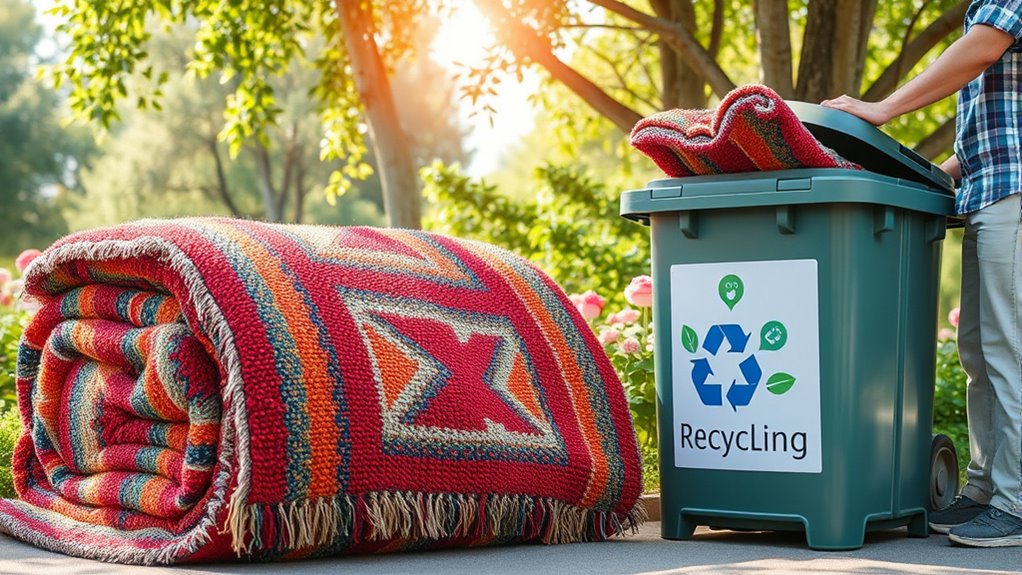
Selling or giving away rugs online or through community groups offers a simple way to find new owners and prevent waste. To maximize your chances, assure your rug looks its best by performing rug cleaning and stain removal. Clean rugs attract more interest and help new owners see their potential. When listing, include clear photos and honest descriptions of any stains or wear.
Consider these tips:
- Use appropriate cleaning products to remove stains and odors, boosting appeal.
- Highlight unique features or materials that may attract specific buyers or groups.
- Be transparent about any damage or stains, and suggest possible repairs or cleaning solutions.
Tips for Extending the Life of Your Rugs to Reduce Waste
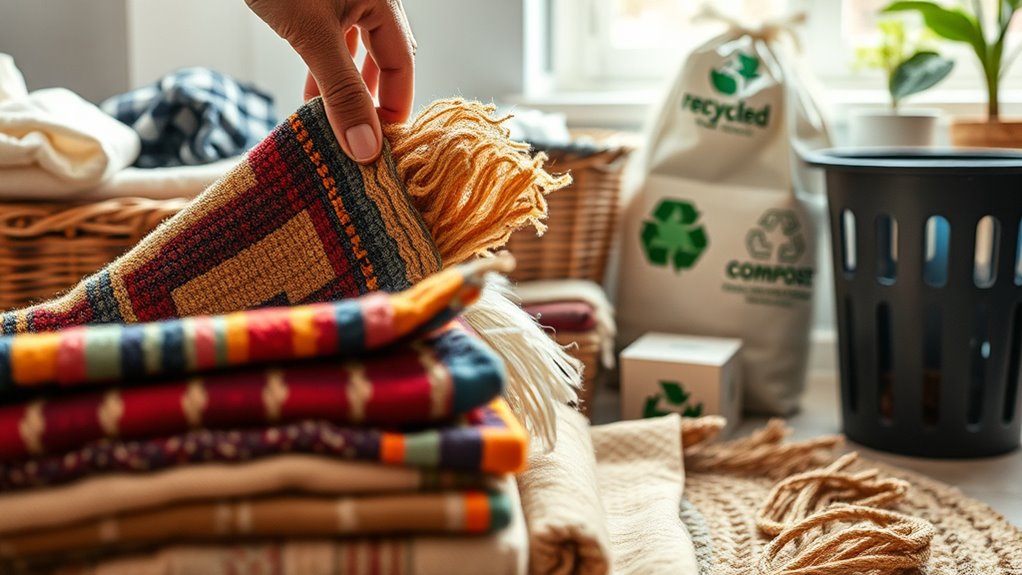
Once you’ve found new owners for your rug or given it a second life through community sharing, taking steps to extend its durability becomes key to preventing waste. Regular rug pad maintenance ensures your rug stays securely in place and reduces wear caused by shifting. Keep the pad clean and replace it if it becomes worn or damaged. Implement stain prevention tips like promptly blotting spills, using protective coatings, and avoiding harsh cleaners. Regular vacuuming removes dirt and debris that can wear fibers down over time. Rotate your rug periodically to distribute foot traffic evenly and prevent uneven fading or wear. Addressing minor issues early, like loose threads or small stains, helps maintain its appearance and integrity longer. These simple practices markedly prolong your rug’s lifespan, reducing the need for disposal.
Frequently Asked Questions
How Can I Identify Environmentally Friendly Rug Disposal Methods?
To identify environmentally friendly rug disposal methods, look for options that prioritize sustainability. Check if the method supports upcycling initiatives or repurposes old rugs creatively. Also, choose disposal options that use biodegradable materials, ensuring minimal environmental impact. Reputable recycling centers often promote these practices. By selecting services that emphasize eco-conscious practices, you help reduce waste and support sustainable initiatives. Always research and ask about their commitment to eco-friendly disposal methods.
Are There Specific Certifications to Look for in Eco-Friendly Rug Recycling Facilities?
They say “trust but verify,” and that’s true for eco-friendly rug recycling facilities. You should look for certification standards that guarantee responsible practices. Eco label programs like GRS or OEKO-TEX set benchmarks for sustainability and safety. These certifications show the facility meets rigorous environmental and social criteria, giving you confidence that your rug is recycled responsibly and sustainably, aligning with your eco-conscious values.
What Are the Environmental Impacts of Rug Incineration Versus Landfilling?
When comparing rug incineration to landfilling, you should know that incineration releases synthetic fibers’ chemicals into the air, contributing to pollution and health risks. Landfilling can cause chemical leaching, contaminating soil and water over time. Incineration often has higher carbon emissions, while landfills take longer to decompose. Both methods harm the environment, so choosing eco-friendly disposal options helps reduce your rug’s ecological footprint.
Can Natural Fiber Rugs Be Composted Safely at Home?
You can compost natural fiber rugs at home, but make sure they’re free from synthetic fibers and chemical treatments. Synthetic fibers and chemicals can contaminate your compost, making it unsafe. Check if your rug is 100% natural—like wool, jute, or cotton—before adding it. Remove any non-biodegradable elements, and cut the rug into smaller pieces to speed up decomposition. Properly composted, these rugs can enrich your garden soil naturally.
How Do Local Regulations Influence Eco-Conscious Rug Disposal Options?
Like a compass guiding your journey, local regulations shape your rug disposal options. You’ll find local zoning laws act as the map, steering you clear of hazards, while hazardous waste rules mark the forbidden zones. These regulations keep your eco-conscious efforts on the right path, ensuring you don’t inadvertently harm the environment. By understanding these rules, you can navigate disposal safely and responsibly, turning your rug’s end into a step toward sustainability.
Conclusion
So, next time you’re about to toss that old rug, remember—you’re just recycling your home’s biggest landfill. Ironically, the eco-friendly options are often right at your fingertips, from donating to upcycling. Instead of adding to waste, you could give your rug a new life or creative purpose. It’s amusing how thinking green can be as simple as choosing to reuse, proving that sometimes, the best way to be eco-friendly is just to hold on a little longer.
